
All images © by Roberto Piperno, owner of the domain. Write to romapip@quipo.it.
Notes:
Page added in June 2025.

All images © by Roberto Piperno, owner of the domain. Write to romapip@quipo.it.
Notes:
Page added in June 2025.
 in the XVIIth century!
in the XVIIth century!In April 2025 Barocco Globale, a temporary exhibition focussing on how in the XVIIth century Rome came into contact with peoples and countries beyond Europe's borders opened at Scuderie del Quirinale. Many of the exhibits were loaned by Roman museums, chiefly Galleria Borghese and Galleria Nazionale d'Arte Antica di Palazzo Barberini. The illustration of this topic is complemented by images of frescoes which can be seen in Roman churches and palaces.
The depiction of people from faraway lands can be noticed already in ancient reliefs where they contributed to the celebration of the glory of an emperor, e.g. the Apadana of Persepolis or Colonna Traiana in Rome. The black marble head is generally thought to be a work of the IInd century AD whereas the bust supporting him was most likely made by a member of the Della Porta family of sculptors in the late XVIth century. Art historians are still divided about the personage it portrays, because it does not fit with the traditional iconography of a barbarian because of his hairstyle; it has been suggested it might be an Indian ambassador because Cassius Dio reports that: Upon Trajan's return to Rome ever so many embassies came to him from various barbarians, including the Indi. (Roman History - LXVIII; 15)
The bust by Antonio Caporale, an assistant of Carlo Maderno, portrays an actual ambassador who was sent by Alvaro II, King of Congo, to Pope Paul V to support the request that the bishop of a newly established diocese of Congo and Angola was to be appointed directly from Rome and not by the Portuguese. The ambassador arrived on December 31, 1607, after a journey which lasted three years and he died three days later, but the memory of his death was set to the night of the Epiphany when Balthazar, one of the Magi who is traditionally referred to as the King of Arabia, gave the gift of myrrh to Jesus. The Pope commissioned the monument which was based on a funerary mask and is remarkable for the use of different marbles.
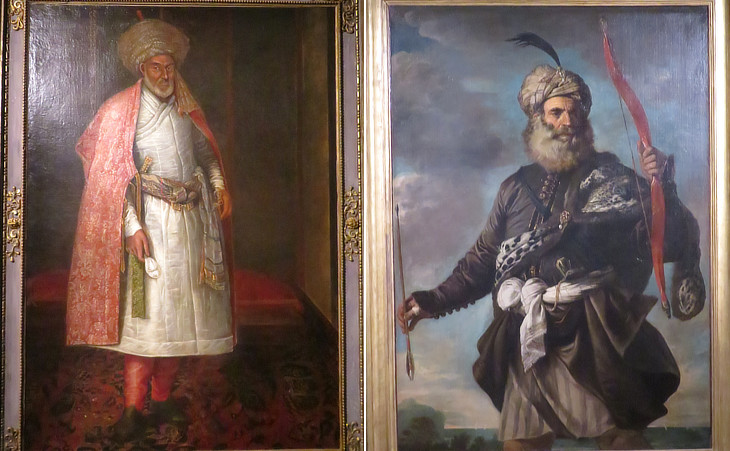
(left) Persian Ambassador Ali-Qoli Beg by Lavinia Fontana (1609), the first female painter to be admitted to Accademia di San Luca (Private Collection); (right) Oriental Warrior by Pier Francesco Mola (1650 - Louvre)
Ali-Qoli Beg was the envoy of Shah Abbas I, the Safavid Emperor of Persia who was at war with the Ottoman Empire. The purpose of his mission was to establish a military alliance and to improve trade with European powers. A fresco in the Vatican Library shows Ali-Qoli Beg kissing the toe of Pope Paul V. The members of his retinue were portrayed in a hall of Palazzo del Quirinale. Some of them wore a turban decorated with aigrette feathers supported by a large brooch, similar to what the Ottomans did (see a painting at Palazzo Colonna).
The imaginary personage portrayed by Pier Francesco Mola is most likely a Persian commander. The fact that he holds a bow with an arrow is consistent with the iconography of the Persians in antiquity. The image used as background for this page shows a turban of a Persian envoy at Palazzo del Quirinale.
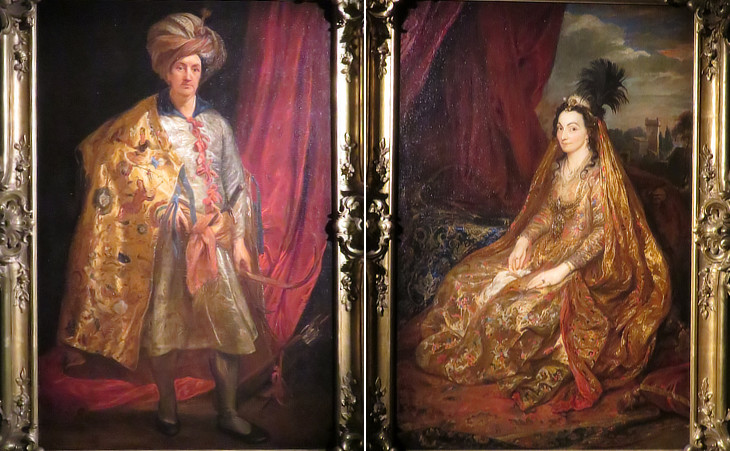
Portraits of Sir Robert Shirley, Persian Ambassador and of his wife Teresia Sampsonia, made in Rome in 1622 by Antoon van Dyck (The National Trust Collections, Petworth House)
Sir Robert Shirley was an English Catholic traveller and adventurer who helped Shah Abbas in modernising and improving the Safavid army according to the British mode and in particular in the use of firearms. When in Persia he married Sampsonia, a lady of the Circassian nobility, who was baptized by the Carmelites as Teresia. In 1608 Shirley accompanied Ali-Qoli Beg in his European tour. In 1615 he returned to Europe with his wife and he mainly lived in Madrid. In 1627 he accompanied Sir Dodmore Cotton, the first British Ambassador to Persia, but he died soon after arriving at Qazvin. Teresia Sampsonia retired to the Carmelite nunnery of S. Maria della Scala in Rome where she died in 1668.
The Circassians, a people who lived in the Caucasus, were known for the valour of their men and the beauty of ther women. It is said that some Ottoman sultans had Circassian blood because many of the concubines in the Harem were of Circassian origin. Also the local Ottoman rulers often had a Circassian concubine or wife, e.g. Emir Beshir of the Druzes.
Shah Abbas' policy of openness towards foreigners led other Europeans to travel to his country. Pietro della Valle, of a Roman noble family, visited Isfahan with Ma'ani his young wife, a Christian girl from Mardin.
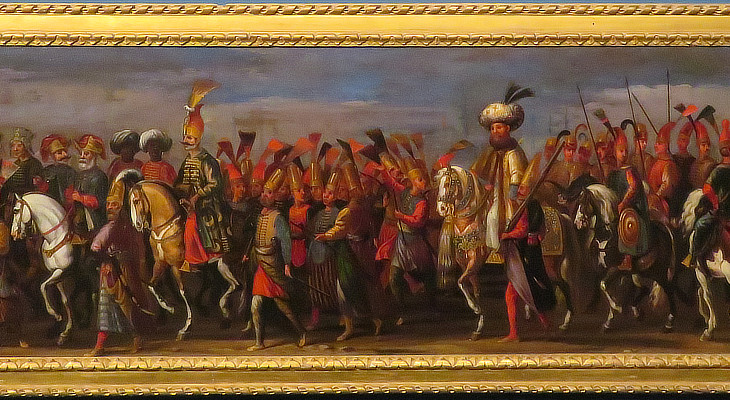
Cortège of an Ottoman Sultan by Giovanni Maria Ferri (1628 - Palazzo Barberini, based on an earlier depiction of the event by Antonio Tempesta)
The 1453 Fall of Constantinople was a shock for Western Europe. Il Gran Turco, as the Venetians called the Ottoman Sultan, soon showed his might by conquering many Aegean islands and in 1480 by conquering Otranto, a fortress at the southern end of the Italian peninsula. There were seven wars between Venice and the Ottoman Empire (the last one ended in 1718), but there were also long periods of peace and good trade relations. In some Italian Renaissance paintings enemies of the Roman Empire were portrayed as Turks, e.g. Hannibal, but the costumes and ceremonies of the Ottoman court fascinated many artists. The Bailo, the Venetian Ambassador to the Sultan, provided detailed accounts of them. The 1571 victory at Lepanto was celebrated in numberless works of art depicting the route of the Turkish fleet, e.g. at Palazzo Colonna and Fontana dei Quattro Mori at Marino, but the painting by Ferri was made during a long interval of peace (1573-1645).
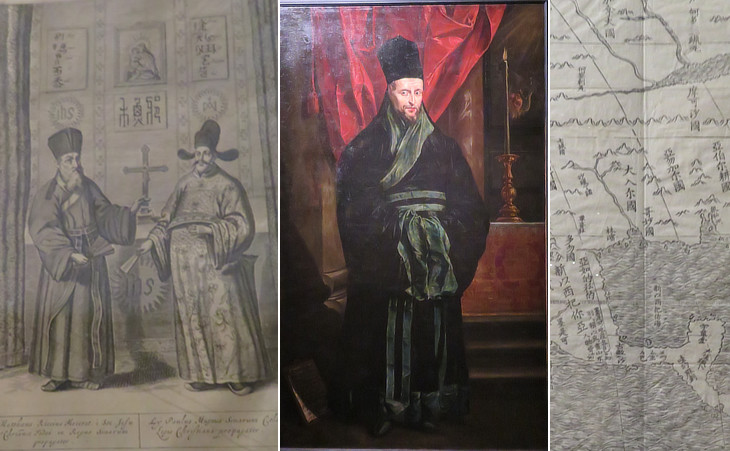
(left) Matteo Ricci and Xu Guangci, engraving from a book on China by Athanasius Kircher; (centre) Nicolas Trigault, a Belgian Jesuit, in Chinese costume (made in Rome in 1615 by Peter Paul Rubens - Douai, Musée de la Chartreuse); (right) detail showing the Gulf of Mexico from a 1602 map of the world drawn by Matteo Ricci and Li Zhizao (Vatican Library)
Embassies and ambassadors were not the only source of contacts between Rome and faraway countries. The missionary activities of some religious orders, e.g. the Jesuits, and the overall coordination of them by Collegio di Propaganda Fide greatly increased the knowledge of the world outside Europe.
Matteo Ricci (1552-1610), a prominent Italian Jesuit missionary, and his Chinese contemporary Xu Guangci (1562-1633), an agronomist, astronomer, mathematician, politician, and writer are shown wearing traditional Chinese palace robes and standing in front of a Christian altar. Ricci travelled to China in 1582 to spread Catholicism. He learned Chinese and befriended government officials such as Xu Guangci, creating the initial contacts that bridged cultures. Matteo Ricci brought to China the advanced geographical and astronomical knowledge which Europe had acquired in the XVIth century (see a XVIIth century sundial at Convento di Trinità dei Monti indicating the hour in the most faraway countries).
Nicolas Trigault reached China in 1610 and in 1614 he returned to Europe to report to the Pope about the situation of the Church in China, to gain financial support for the missions and to ask for the authorization to use mandarin in ceremonies. The authorization was given, but it was never implemented.
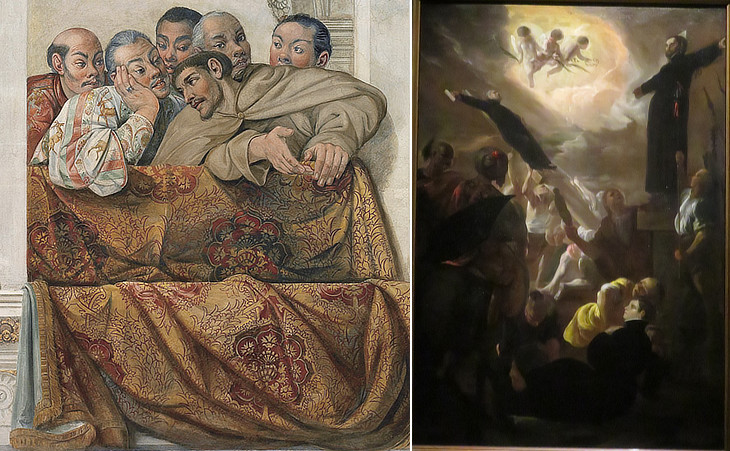
(left) Palazzo del Quirinale: Rokuemon Hasekura, Franciscan Father Luis Sotelo and four Japanese dignitaries by Agostino Tassi and others (1617); (right) The Jesuit Martyrs of Nagasaki by Johann Heinrich Schönfeld (1643, Naples, Museo Civico Castel Nuovo).
In 1615 Pope Paul V received an embassy led by Rokuemon Hasekura, a Japanese feudal lord who had converted to Catholicism. The purpose of the mission was a commercial one, i.e. to establish a direct trade route between Japan and the Viceroyalty of New Spain (Mexico) without going through the Captaincy General of the Philippines. The Japanese mission reached Spain via Acapulco and Veracruz and was received by King Philip III of Spain who however was reluctant to agree to the proposal. Hasekura decided to travel to Rome to obtain the support of Pope Paul V. The Japanese mission was eventually inconclusive because in the meantime all Christian missionaries were banished from Japan and in the 1630s a proper persecution forced Catholicism to be driven underground. Nagasaki was the town which had the largest Catholic population and where in 1597 twenty-six Christians were crucified, among whom three were Jesuits. They were beatified in 1627 by Pope Urban VIII and canonized in 1862.
The painted frieze along the walls of the Sala Regia, now Sala dei Corazzieri, was designed by Agostino Tassi, but he was responsible only for the decorative framework, and Lanfranco and Carlo Saraceni executed the figures. Tassi painted also the architectural frame of Sala dell'Aurora at Casino del Monte.
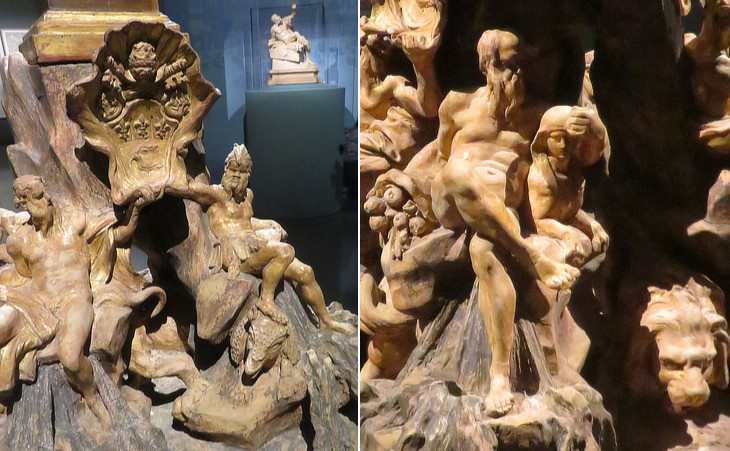
Model of the Fountain of the Four Rivers by Gian Lorenzo Bernini (Collection of Fabiano Forti Bernini): (left) personification of an American river and small model of the actual statue portraying Rio de la Plata; (right) personification of the River Nile
Pope Innocent X decided to embellish Piazza Navona with a new fountain for the Jubilee Year 1650. Gian Lorenzo Bernini was not invited to submit a project, as the Pope reproached him with being too closely associated with his predecessor Pope Urban VIII, but Bernini found a way to have a model of his project shown to the Pope who immediately assigned the work to him. He then designed a larger model which is still the property of his family. The four Rivers were meant to represent the four continents upon which the Catholic Faith descended. For the River representing America he relied on Cesare Ripa's 1603 Iconology: AMERICA: A Woman almost naked; a tann'd Aspect; has a Veil folded over her Shoulder; round her Body, an artificial Ornament of Feathers of divers Colours, in one Hand a Bow, and a Quiver by her Side; under one Foot a human Head pierc'd with an Arrow, and a Lizard on the Ground. Naked, because the Inhabitants are all so. The Arms are what both Men and Women use there. The Head shews that they are Cannibals. The Lizard, they are so big here, that they devour Men. (1709 translation by Pierce Tempest).
Bernini's initial personification of the American river wore feathers and stood over a gigantic lizard. The artist however was aware that by 1650 many parts of America were populated by African slaves and he departed from Ripa's iconography to create a new more theatrical depiction of the river. The Nile too was initially designed according to its ancient iconography, but eventually Bernini adopted a more forceful image of that river.
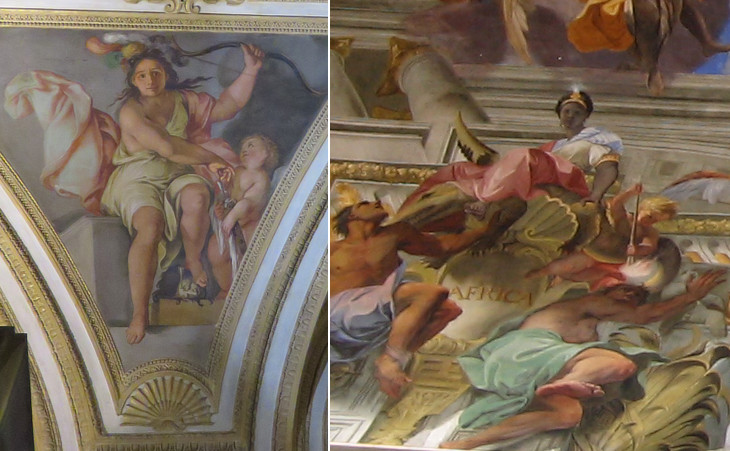
(left) Oratorio del Caravita: Allegory of America by Lazzaro Baldi (ca 1673); S. Ignazio: Allegory of Africa by Father Andrea Pozzo (1691-1694)
The Jesuits were the leaders of the missionary efforts of the Catholic Church and in their Roman churches they depicted the four continents where they operated. The Allegory of America at Oratorio del Caravita is perfectly in line with Ripa's iconology, whereas Father Pozzo departed from it and chose to depict Africa as a princess, rather than a savage naked woman, and in the act of stamping out two giants representing Vice and Heresy. The change underlines a better understanding of the complexity of that continent. See other allegories of the continents at Palazzo Pamphilj of Valmontone and at S. Pantaleo.
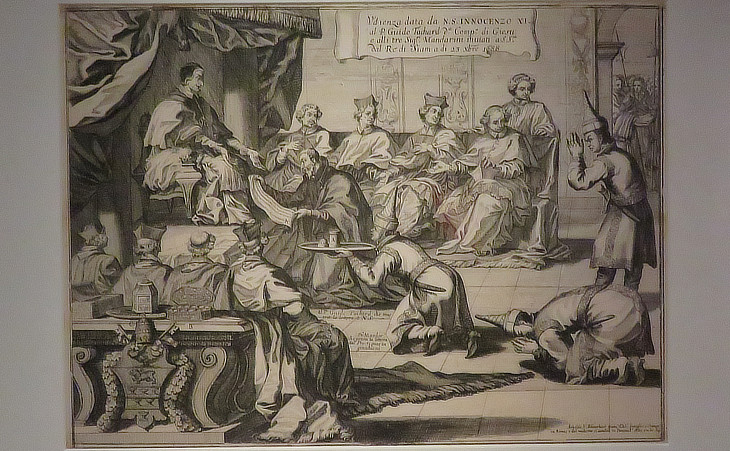
Engraving depicting Jesuit Father Guy Tachard introducing the envoys of Narai, King of Siam, to Pope Innocent XI in 1688, from a drawing by Carlo Maratta
In the XVIIth century Siam (the official name of Thailand until 1939) was at the centre of a competition among the British, French and Dutch Companies of the Indies to open its markets to European products. Narai was king of Siam in 1656-1688 and he sought the support of King Louis XIV of France and in the 1680s he allowed French troops to be stationed in Siamese ports. The French penetration into Siam was supported by the Jesuits. In January 1688 a mission of three Siamese mandarins, accompanied by the Jesuit Father Guy Tachard left Siam for France. After a first visit to Paris the envoys travelled to Rome and met with the Pope on 23 December 1688, and again on 5 January 1689, for a farewell audience. In the meantime however King Narai passed away and his successor attacked the French troops and he allowed only the Dutch to trade in Siam. The Jesuits' hopes of establishing a Catholic kingdom in Siam faded away.
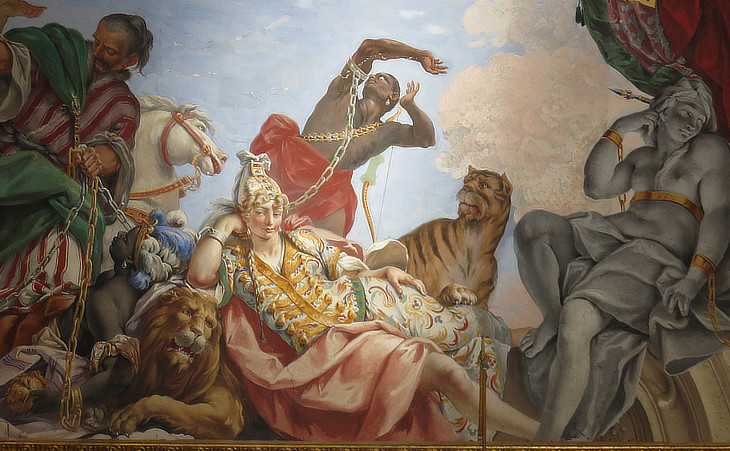
Palazzo Colonna - Sala Grande: detail of the fresco depicting the Battle of Lepanto by Giovanni Coli and Filippo Gherardi; it shows an attractive young blonde slave in a very relaxed posture while behind her an Ottoman pirate captures other prisoners and wild animals; the fresco was painted in 1675-1678 and it could be a reference to Turhan Hatice Sultan, mother of Sultan Mehmet IV, who was rumoured to be of Russian origin and of having been captured as a slave at the age of twelve
Although the expansion of Catholicism was not that foreseen at the beginning of the XVIIth century the Romans were impressed by the variety and novelty of the costumes of the envoys and by the works of art and accounts which the Jesuits and other missionary orders sent to their headquarters in Rome. A fashion developed for the depiction of exotic subjects, including animals and plants, especially in the decoration of palaces. A similar trend known as Orientalism developed in France after the conquest of Algeria in 1830.

